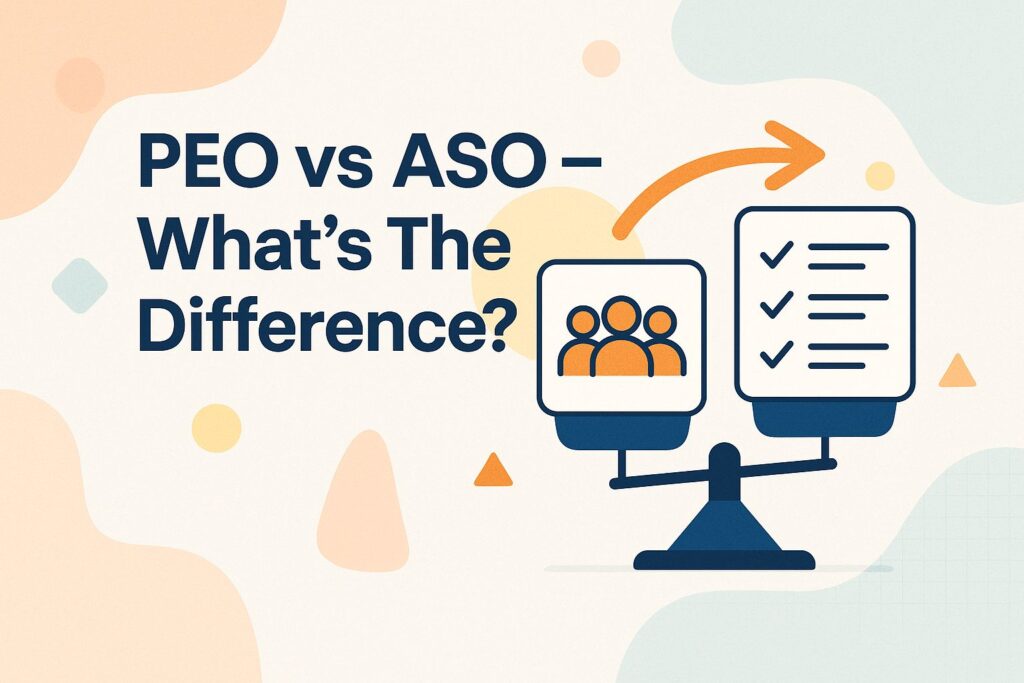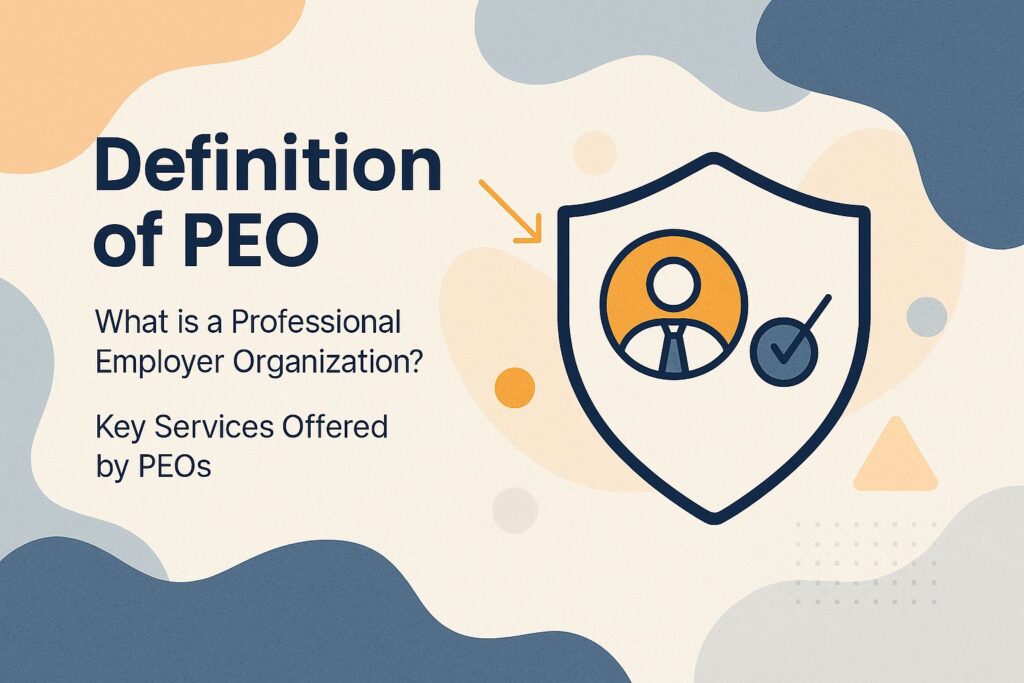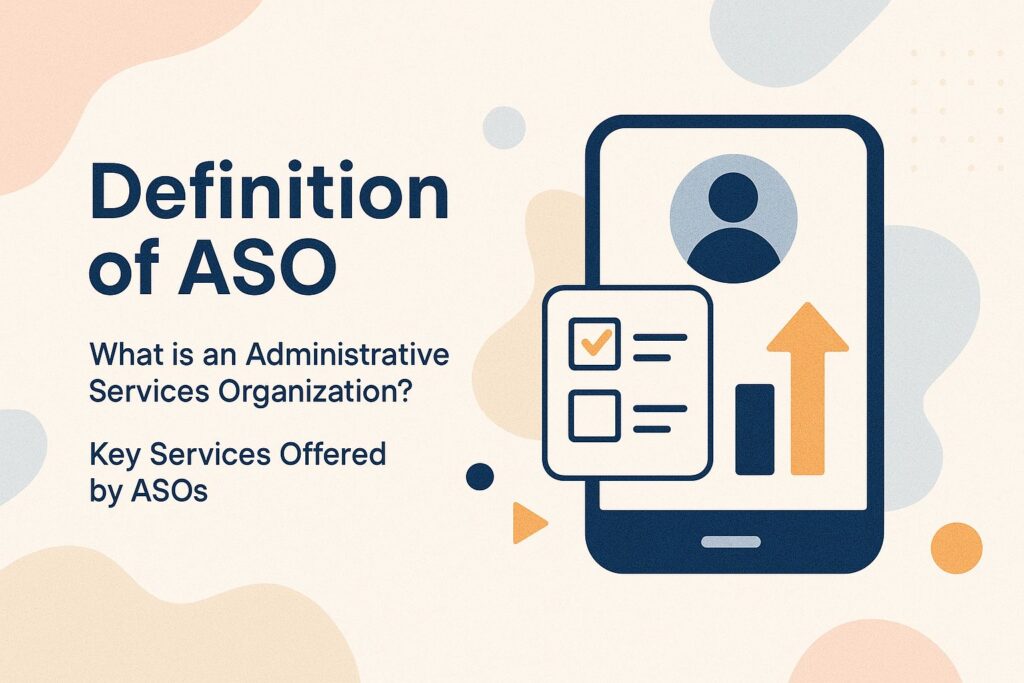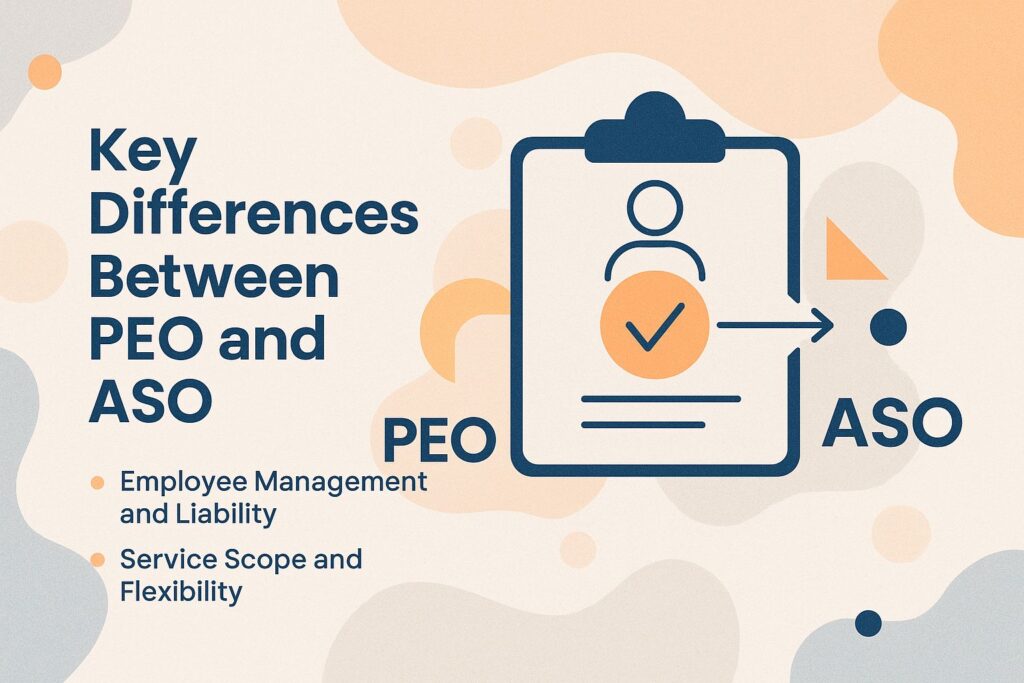
PEO vs ASO – What’s The Difference?
Dealing with employee management can be challenging, especially when choosing between a PEO and an ASO. Knowing the differences between these two services is key to improving how your business runs. This article explains what PEOs and ASOs provide, points out their main differences, and looks at the benefits of each. By the end, you’ll know which option works best for your company’s needs.
Definition of PEO
A Professional Employer Organization (PEO) provides a full range of human resource services. It works with companies to handle tasks related to employees, including payroll, benefits, and following the rules.

What is a Professional Employer Organization?
PEOs operate through a shared employment arrangement, dividing employer responsibilities with client companies to simplify HR tasks.
This arrangement significantly benefits businesses by alleviating HR burdens, as PEOs handle payroll, benefits administration, and regulatory compliance.
For example, a small tech startup may use a PEO to manage employee onboarding and maintain compliance with labor laws, allowing its team to focus on driving innovation.
PEOs can offer competitive benefits packages that attract top talent, which individual businesses might struggle to provide on their own.
Working with a PEO helps build a positive workplace that encourages growth and steadiness.
Key Services Offered by PEOs
PEOs provide a suite of services including payroll processing, employee benefits administration, compliance assurance, risk management, and strategic HR functions.
These services improve HR tasks, especially for small businesses with limited resources.
For example, payroll processing ensures salaries are paid correctly and on time, reducing errors with software like Gusto or ADP.
Handling employee benefits makes it easy to access plans and helps in hiring talented workers.
Following labor laws can be complicated, but software like Zenefits can help businesses stay updated on regulations.
Risk management finds possible problems, protecting the company and reducing the workload of HR in dealing with these complicated tasks.
These features work together to make HR processes smooth and easy, aligning with the strategies outlined in our guide to simplify business operations.
Definition of ASO
An Administrative Services Organization (ASO) offers specific administrative help customized to each person’s requirements. This lets businesses manage their employees while outsourcing specific HR tasks.

What is an Administrative Services Organization?
ASOs are dedicated to offering specific HR services, such as payroll processing, employee training, and vendor management, while clients maintain the employer-employee relationship.
This model helps businesses simplify operations while keeping control. For example, a company might use an ASO like Justworks for payroll and compliance while retaining its usual HR staff for recruitment and management.
ASOs can provide technological tools such as time-tracking software and employee onboarding platforms, which work together with existing systems. By hiring outside help for these tasks, companies can focus on their main activities while routine work is completed smoothly and without problems.
Key Services Offered by ASOs
Common services provided by ASOs include handling payroll, helping with following regulations, training employees, and managing benefits to fit what clients need.
These services stand in contrast to PEOs, which often bundle HR functions into a co-employment arrangement, facilitating shared services and employee leasing.
ASOs offer flexibility by allowing businesses to choose specific services based on their unique needs, whether that’s integrating advanced payroll software like Gusto or utilizing compliance experts for industry-specific regulations. For those interested in leveraging technology, it’s beneficial to consider comparing HR software costs in 2025..
For instance, a tech startup may prioritize employee training programs focusing on agile methods, while a manufacturing firm might benefit more from safety compliance consultations.
This custom method helps businesses stay in charge while improving their HR tasks.
Key Differences Between PEO and ASO
Knowing the main differences between PEOs and ASOs is important for businesses to figure out which model fits their operations best. For those looking to delve deeper into selecting the right model, discover how to find the perfect HR solution for your unique needs.

Employee Management and Liability
One primary distinction is that PEOs share employment liability with their clients, while ASOs allow businesses to retain full liability and control over employees.
This difference significantly influences how businesses manage risk and structure their HR practices. For instance, a company using a PEO can offload certain employment-related headaches, such as compliance and payroll, while still sharing liability.
Alternatively, companies using an ASO handle their staff directly. This can lead to more customized HR plans, but they also assume all legal obligations. This model can be less burdensome during audits but demands careful employee oversight to avoid potential liabilities.
Service Scope and Flexibility
PEOs generally provide a broad range of HR services as a full package, covering employer duties and workforce data analysis. On the other hand, ASOs provide more flexible, customized options to address specific business needs.
This flexibility allows businesses to tailor services according to specific requirements, such as payroll processing, risk management, or compliance training.
For instance, an ASO may focus solely on providing payroll services to a tech startup while offering customized training modules for a manufacturing firm, addressing their unique regulatory needs.
In contrast, a PEO might bundle these services into one package, which may not fully align with the distinct demands of varied industries. The ability to change can greatly affect a company’s growth strategy, resulting in better distribution of resources.
Benefits of Using PEOs
Using a PEO can lead to clear benefits, such as reduced paperwork, better compliance with regulations, improved employee benefits, and more workforce flexibility.
PEOs offer important payroll and tax management services, which can reduce expensive mistakes. For example, by outsourcing payroll, businesses can reduce the risk of penalties due to tax miscalculations-this can save companies thousands annually.
PEOs often offer full health insurance plans, which help attract qualified employees. According to a study, companies using PEOs see an average reduction of 10-20% in employee turnover, ensuring a more stable workforce.
This combination of effective methods improves business performance. See also: HR Outsourcing Methods and Options for more strategies that enhance efficiency and compliance.
Benefits of Using ASOs
Administrative Service Organizations (ASOs) help companies by offering specialized help with administrative tasks, resulting in better work efficiency, easier management of performance, and allowing businesses to concentrate on their main activities.
By offloading tasks like scheduling, data entry, and customer support, businesses can redirect resources toward strategic initiatives.
For instance, a small e-commerce company might use an ASO to handle order processing and manage inventory, allowing the owner to concentrate on marketing and product development.
Using tools like Trello to keep track of projects and Slack for communication can improve teamwork between the ASO and the company, simplifying tasks and supporting growth by managing client relationships effectively.
Such strategies have enabled many firms to scale quickly while maintaining quality service.
Choosing the Right Option for Your Business
Selecting between a PEO and ASO requires careful consideration of your business size, HR needs, and the level of control desired over employee management.
To make an informed choice, ask yourself: What specific HR functions do we need? How much control do we want over payroll and employee policies?
For example, a PEO can help small businesses with employee benefits and compliance support, while an ASO can give larger companies more control over their custom HR solutions and employee classification. Those who are curious about how these solutions can simplify overall business operations might appreciate our guide to HR management.
Consider the pros and cons: PEOs handle administrative tasks but may limit your control, while ASOs offer customized services but need more in-house management. Knowing what matters most to you is essential.
About the Author
Ellen Westbrook is a Stanford University graduate with a bachelor’s degree in human resources and psychology. She’s the owner of a successful HR and payroll outsourcing firm in Colorado and a contributing writer for HR Costs. With 17 years of experience, Ellen helps businesses reduce risk, manage HR more efficiently, and grow with confidence.

